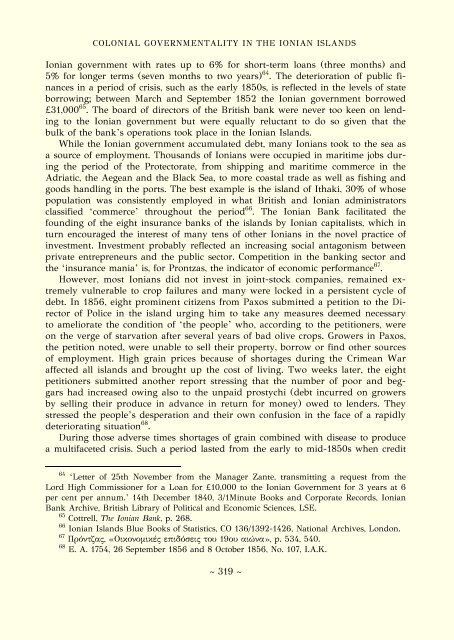You also want an ePaper? Increase the reach of your titles
YUMPU automatically turns print PDFs into web optimized ePapers that Google loves.
COLONIAL GOVERNMENTALITY IN THE IONIAN ISLANDS<br />
Ionian government with rates up to 6% for short-term loans (three months) and<br />
5% for longer terms (seven months to two years) 64 . The deterioration of public finances<br />
in a period of crisis, such as the early 1850s, is reflected in the levels of state<br />
borrowing; between March and September 1852 the Ionian government borrowed<br />
£31,000 65 . The board of directors of the British bank were never too keen on lending<br />
to the Ionian government but were equally reluctant to do so given that the<br />
bulk of the bank’s operations took place in the Ionian Islands.<br />
While the Ionian government accumulated debt, many Ionians took to the sea as<br />
a source of employment. Thousands of Ionians were occupied in maritime jobs during<br />
the period of the Protectorate, from shipping and maritime commerce in the<br />
Adriatic, the Aegean and the Black Sea, to more coastal trade as well as fishing and<br />
goods handling in the ports. The best example is the island of Ithaki, 30% of whose<br />
population was consistently employed in what British and Ionian administrators<br />
classified ‘commerce’ throughout the period 66 . The Ionian Bank facilitated the<br />
founding of the eight insurance banks of the islands by Ionian capitalists, which in<br />
turn encouraged the interest of many tens of other Ionians in the novel practice of<br />
investment. Investment probably reflected an increasing social antagonism between<br />
private entrepreneurs and the public sector. Competition in the banking sector and<br />
the ‘insurance mania’ is, for Prontzas, the indicator of economic performance 67 .<br />
However, most Ionians did not invest in joint-stock companies, remained extremely<br />
vulnerable to crop failures and many were locked in a persistent cycle of<br />
debt. In 1856, eight prominent citizens from Paxos submitted a petition to the Director<br />
of Police in the island urging him to take any measures deemed necessary<br />
to ameliorate the condition of ‘the people’ who, according to the petitioners, were<br />
on the verge of starvation after several years of bad olive crops. Growers in Paxos,<br />
the petition noted, were unable to sell their property, borrow or find other sources<br />
of employment. High grain prices because of shortages during the Crimean War<br />
affected all islands and brought up the cost of living. Two weeks later, the eight<br />
petitioners submitted another report stressing that the number of poor and beggars<br />
had increased owing also to the unpaid prostychi (debt incurred on growers<br />
by selling their produce in advance in return for money) owed to lenders. They<br />
stressed the people’s desperation and their own confusion in the face of a rapidly<br />
deteriorating situation 68 .<br />
During those adverse times shortages of grain combined with disease to produce<br />
a multifaceted crisis. Such a period lasted from the early to mid-1850s when credit<br />
64 ‘Letter of 25th November from the Manager Zante, transmitting a request from the<br />
Lord High Commissioner for a Loan for £10,000 to the Ionian Government for 3 years at 6<br />
per cent per annum.’ 14th December 1840, 3/1Minute Books and Corporate Records, Ionian<br />
Bank Archive, British Library of Political and Economic Sciences, LSE.<br />
65 Cottrell, The Ionian Bank, p. 268.<br />
66 Ionian Islands Blue Books of Statistics, CO 136/1392-1426, National Archives, London.<br />
67 Πρόντζας, «Οικονομικές επιδόσεις του 19ου αιώνα», p. 534, 540.<br />
68 E. A. 1754, 26 September 1856 and 8 October 1856, No. 107, I.A.K.<br />
~ 319 ~



